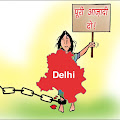Historical background and issues related to the demand for full statehood of Delhi
Delhi city is the second most highly populated region after Mumbai and is now being considered to extend beyond NCT boundary including the neighbouring cities of Faridabad , Gurgaon , Noida and Ghaziabad in an area called Central National Capital Region. According to 2016 census, Delhi had an estimated population of over 26 Million. This makes Delhi the world's second largest urban city after Tokyo. Around 52% of the population of Delhi lives in slums with "Inadequate provision of basic facilities" and around 16% of the people don't have proper toilets.
With this huge population and the deplorable conditions in which more than half of the population is living in, Delhi urgently needs a more people-centric Government.
Full Statehood Debate: Arvind kejriwal led Aam Aadmi Party government recently renewed the debate of full statehood for Delhi. Although all major political parties called for full statehood of Delhi and endorsed it every time as a poll promise, none have walked the talk once they came into power.
Acts and Amendments: Delhi experienced its first directly elected Legislative Assembly in 1952 led by Chaudhary Brahm Prakash. The state government was provided with the power of making laws for Delhi on all matters of State and concurrent lists of Schedule 7 except matters pertaining to a) Public law and order b) Police c) Land d) Municipal services such as water, drainage, electricity, transport e) jurisdiction of courts. Later these were rescinded after the enactment of State reorganization Act, 1956. It recognized Delhi as a Union Territory under section 21 (part C) of the Act. This implied that Delhi was meant to be a separate state with its own Government by the Constitution of India.
Committees on Statehood: Prabhu committee in 1975 also recommended greater say of Delhi-ites in matters of administration but no action was taken by successive Governments. Rajiv gandhi led Congress Government also constituted a fresh committee and based on its recommendations, the 74th Amendment bill was passed by both the houses of parliament. National capital territory of Delhi Act, 1991 provisioned an elected legislative Assembly with council of ministers headed by CM. It also made Lt. Governor (LG) appointed by central government as the head of Administrative matters. This led to the introduction of Article 239AA and 239AB in the constitution which provided powers to enact laws on all the state matters and concurrent list except law and order, police, land etc. The change created loopholes and provided executive powers to the LG. In case of any difference of opinion between LG and the cabinet , LG would refer the matter to the President for final decision and was granted autonomy to take decisions as per his/her discretion in urgent and critical cases (even if it differed from the elected cabinet).
The Drift: Things were working fine until both central and Union Territory governments were ruled by the same party but contention started when both the government were not in agreement and hampered their political aspirations. Recent Delhi high court verdict stated LG as the administrative head which made matters more complicated. This situation worsened due to the disharmony between BJP led central Government and AAP led Delhi government.
Accountability: Basic requirements for giving statehood to Delhi is to get control of Delhi police to make it accountable for law and order as well as acquisition of land for various infrastructural projects. For instance, AAP promised women security and 1000 mohalla clinics in its manifesto but both projects are only half way due to lack of executive power assigned to the elected Delhi Government.
Conflicting Control: Multiplicity of various bodies controlled by both centre and state is also causing confusion. For example, Delhi Development Authority (DDA) which comes under Ministry of Urban development of GOI was created to ensure organized development of Delhi in 1955. It has the responsibility of housing, infrastructure and commercial facilities and has no obligations to obey elected representatives. Delhi police reports to union home ministry and have no official accountability to the state government.
Examples around the World; Most developed countries have made even very small cities as their administrative capital for serving the administrative purpose such as Washington DC, Ottawa, Canberra etc. However, cities such as New York city with various embassies and UN headquarter has local police and run by mayor in a fashion similar to the system followed in London.
The Solution to Statehood: New Delhi Municipal Corporation (NDMC) which represents the seat of central government, supreme court and most embassies is already governed by council with a chairman appointed by the central government. NDMC can have separate legislative and executive jurisdiction and an autonomous central controlled police force.
Granting full state hood would ensure all agencies that are currently under the control of Union government would be answerable to NCT Delhi. Moving forward in the demand for statehood, more light will also be shed on the intentions of other political parties who asked for statehood as AAP has already launched a full-fledged campaign in this direction.
Author Preity Gurjar works with AAP Maharastra team. While working with ground volunteers, she handles the donation drive and love to write about AAP policies and developments. She can be followed on twitter @gurjarpreity19.






No comments